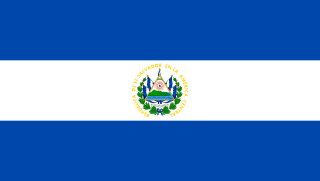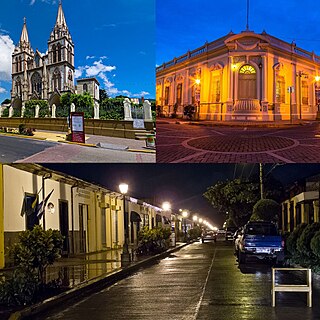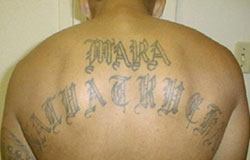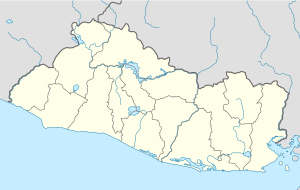
Central America is a region of the Americas. It is bordered by Mexico to the north, Colombia to the south, the Caribbean Sea to the east, and the Pacific Ocean to the west. Central America consists of seven countries: Belize, Costa Rica, El Salvador, Guatemala, Honduras, Nicaragua, and Panama. Their combined population is estimated at 44.53 million (2016).

El Salvador, officially the Republic of El Salvador, is a country in Central America. It is bordered on the northeast by Honduras, on the northwest by Guatemala, and on the south by the Pacific Ocean. El Salvador's capital and largest city is San Salvador. The country's population in 2021 is estimated to be 6.8 million.

San Salvador is the capital and the largest city of El Salvador and its eponymous department. It is the country's political, cultural, educational and financial center. The Metropolitan Area of San Salvador, which comprises the capital itself and 13 of its municipalities, has a population of 2,404,097. The urban area of San Salvador has a population of 1,600,000 inhabitants.

Earthquakes are caused by movements within the Earth's crust and uppermost mantle. They range from events too weak to be detectable except by sensitive instrumentation, to sudden and violent events lasting many minutes which have caused some of the greatest disasters in human history. Below, earthquakes are listed by period, region or country, year, magnitude, cost, fatalities and number of scientific studies.

Santa Ana is the second largest city in El Salvador, after the capital of San Salvador. It is located 64 kilometers northwest of San Salvador, the capital city. Santa Ana has approximately 374,830 (2017)) inhabitants and serves both as the capital of the department of Santa Ana and as the municipal seat for the surrounding municipality of the same name. For its administration the municipality is divided into 35 colonias (neighborhoods) and 318 small villages.

La Libertad is one of the departments of El Salvador and is located in the southwest of the country. The capital is Santa Tecla. It has area 1,653 km² and a population of more than 747,600 people.

José María San Martín was a military officer, politician and President of El Salvador.
San Juan Tepezontes is a municipality in the La Paz department of El Salvador. Its name is a Hispanicization of a Nawat term meaning "many hills." It was incorporated in 1945. Its population as of 2004 was 3,269.

La Libertad«Liberty» is a municipality in the La Libertad Department of El Salvador. It had a population of 35,997 inhabitants in 2007 according to the official census of that year. It is one of the main tourist attractions in the country.

Santa Tecla is a municipality in the La Libertad department of El Salvador. It is the capital of the department of La Libertad.

The January 2001 El Salvador earthquake struck El Salvador on January 13, 2001 at 17:33:34 UTC. The 7.6 quake struck with the epicenter 60 miles (100 km) SW of San Miguel, El Salvador at a depth of 60 km. At least 944 people were killed, 5,565 injured, 108,261 houses destroyed – with another 169,692 houses damaged – and more than 150,000 buildings were damaged in El Salvador. About 585 of the deaths were caused by large landslides in Santa Tecla and Comasagua. As is often the case after earthquakes in El Salvador, landslides wreaked significant damage. Estimation of the number of slides is difficult because individual scarps conjoin. The total has been reported as high as 16,000, though it is unclear how this figure was arrived at. Damage and injuries occurred in every department of El Salvador, particularly the departments of La Libertad and Usulután. Eight people were killed in Guatemala. The tremor was felt from Mexico City to Colombia. An aftershock measuring 5.7 magnitude was felt on January 15, an event not widely reported outside the country until after another earthquake on February 13, which initially was assessed by the USGS at 5.7 magnitude as well.
The 1986 San Salvador earthquake occurred at on October 10 with a moment magnitude of 5.7 and a maximum Mercalli intensity of IX (Violent). The shock caused considerable damage to El Salvador's capital city of San Salvador and surrounding areas, including neighboring Honduras and Guatemala.
The El Salvador Reconstruction and Development Project is a charitable volunteer project from Imperial College London's Department of Civil and Environmental Engineering which was launched in reaction to two major earthquakes that struck the country of El Salvador in 2001. The project has a voluntary student membership basis and is concentrated in rural, mainly underdeveloped areas of the country.
The 1982 El Salvador earthquake occurred southeast of San Salvador on 19 June at 00:21 local time. This undersea earthquake struck offshore in the Pacific Ocean and had a surface wave magnitude of 7.3 and a maximum Mercalli intensity of VII. Occurring adjacent to a subduction zone at the Middle America Trench, this normal-slip shock left at least 16 and as many as 43 people dead, and many injured, and also inflicted $5 million in damage.
The 1995 Chiapas earthquake occurred on . The epicenter was located in Ocozocoautla de Espinosa, in the state of Chiapas, Mexico, near Tuxtla Gutiérrez. It had a magnitude of 7.2, or 6.5. Building damage was reported. Around 70 people were reported injured. In Tuxtla Gutiérrez, telephone and electricity services were momentarily interrupted. This earthquake could be felt strongly in Mexico City and in many parts of southern Mexico. It could also be felt in Guatemala and El Salvador. The centroid mechanism is of thrust faulting with a small strike-slip component. The rupture of this earthquake propagated from NW to SE over a distance of about 30 km. The duration of the rupture was about 17 seconds. The earthquake was resulted from the internal deformation of the Cocos Plate, which is subducting beneath the North American Plate.

There are an estimated 25,000 gang members at large in El Salvador; another 9,000 are in prison. The best-known gangs, called maras in colloquial Salvadoran Spanish, are Mara Salvatrucha (MS-13) and their rivals 18th Street; maras are hunted by death squads, including Sombra Negra. Newer rivals include the rising mara, The Rebels 13. Criminal youth gangs dominate life in El Salvador; an estimation of at least 60,000 young people belong to gangs. It is one of the three countries of the Northern Triangle of Central America, along with neighboring Guatemala and Honduras, which are all afflicted with high levels of violence.
The February 2001 El Salvador earthquake occurred with a moment magnitude of 6.6 on 13 February at 14:22:05 UTC. The epicentre was 15 miles (30 km) E of San Salvador, El Salvador. At least 315 people were killed, 3,399 were injured, and extensive damage affected the area. Another 16,752 homes were damaged and 44,759 destroyed. The most severe damage occurred in the San Juan Tepezontes-San Vicente-Cojutepeque area, though it was felt throughout the country and in neighboring Guatemala and Honduras. Landslides occurred in many areas of El Salvador.
The 1965 San Salvador earthquake occurred at 04:01 in the morning on May 3, 1965. It had a moment magnitude of 5.9 and a maximum Mercalli intensity of VIII (Severe). The shock caused severe damage to El Salvador's capital city, San Salvador. The town of Ilopango, Soyapango, and Delgado was also hard hit. The earthquake was the most destructive to affect the city prior to the 1986 earthquake.



















